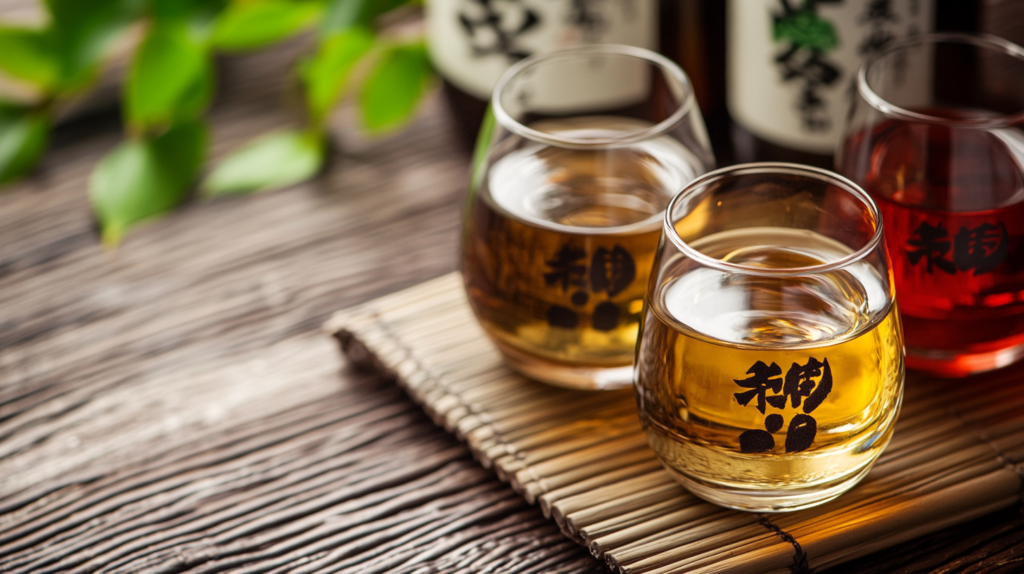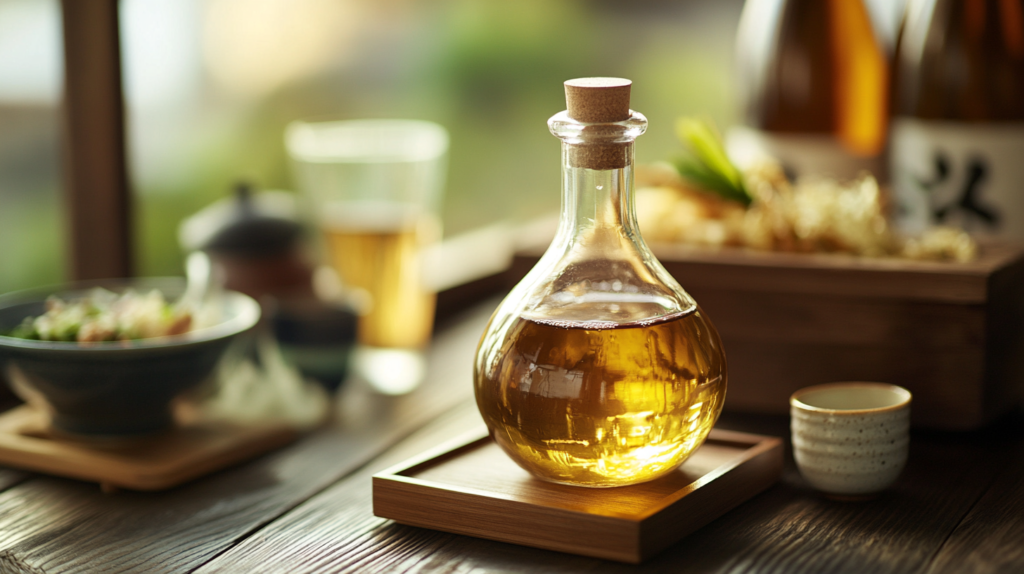What is Mirin?
substitute for mirin in cooking is a sweet rice wine used as a seasoning in Japanese cuisine. Known for its delicate sweetness and subtle tang, it enhances the flavor and appearance of dishes, making it an essential ingredient in Japanese cooking.
Definition and Overview
Mirin is a type of rice wine with a low alcohol content and high natural sugar levels:
- Composition: Made from glutinous rice, rice koji (fermented rice), and shochu (distilled alcohol), mirin undergoes fermentation to develop its signature flavor.
- Flavor Profile: Sweet and mildly tangy, mirin adds depth and umami to dishes, balancing savory and salty flavors.
- Culinary Uses: Commonly used in marinades, glazes, and sauces, mirin gives a glossy finish to foods and enhances their overall taste.
Its versatility and unique flavor make mirin a staple in Japanese cuisine.
History and Cultural Significance
Mirin has a rich history deeply rooted in Japanese culinary traditions:
- Origins:
- First produced during the Sengoku period (15th-16th century) as a sweet alcoholic beverage.
- Over time, its use shifted from drinking to cooking as its flavor-enhancing properties were discovered.
- Role in Japanese Cuisine:
- Mirin became a key ingredient in iconic dishes such as teriyaki, sukiyaki, and tempura dipping sauce.
- Its sweetness balances the salty flavors of soy sauce and miso, creating harmonious flavor profiles.
- Symbolic Importance:
- In traditional Japanese culture, people often included mirin in ceremonial cooking and gift-giving to symbolize prosperity and hospitality.
Today, mirin remains an integral part of both everyday and high-end Japanese cooking.
Types of substitute for mirin in cooking
There are several types of mirin available, each with its own characteristics and uses:
- Hon Mirin (True Mirin):
- Contains about 14% alcohol and is naturally sweet due to fermentation.
- Considered the most authentic type, it is often used in traditional recipes.
- Requires cooking to burn off the alcohol when used as a seasoning.
- Aji Mirin (Mirin-style Seasoning):
- Has a lower alcohol content (less than 1%) or none, with added sweeteners and flavor enhancers.
- Commonly found in supermarkets, it is a budget-friendly alternative to hon mirin.
- Mirin-like Seasonings:
- Non-alcoholic versions made with sweeteners and artificial flavors.
- Used as a substitute in recipes where alcohol is not desired or allowed.
Each type of mirin serves different culinary purposes, offering flexibility for home cooks and professional chefs alike.
Mirin is a versatile and culturally significant ingredient that brings balance, depth, and shine to Japanese dishes. Understanding its types and uses allows you to fully appreciate its role in creating authentic flavors.

How substitute for mirin in cooking is Made
The process of making mirin combines traditional techniques with carefully selected ingredients to create its distinctive flavor and sweetness. From its fermentation process to how it compares with other cooking wines, mirin’s production is both unique and fascinating.
Ingredients in Traditional Mirin
The high quality of mirin comes from its simple yet carefully balanced ingredients:
- Glutinous Rice (Mochigome):
- Provides the base starch, which is broken down into sugars during fermentation.
- Contributes to the natural sweetness of mirin.
- Rice Koji:
- A mold used in fermentation to convert starches into sugars and amino acids.
- Enhances the umami and depth of flavor.
- Shochu (Distilled Alcohol):
- Acts as a preservative and fermentation enhancer, preventing unwanted bacteria.
- Adds mild alcoholic notes and stabilizes the mirin.
These ingredients undergo a meticulous process to achieve the balance of sweetness, acidity, and alcohol characteristic of authentic mirin.
The Fermentation Process
The fermentation process is the heart of mirin production, creating its signature flavor and texture:
- Mixing:
- Glutinous rice, rice koji, and shochu are combined in precise proportions.
- Aging:
- The mixture is left to ferment and mature for several months, allowing natural enzymes to convert starches into sugars and develop its flavor complexity.
- Filtering:
- After fermentation, the mixture is pressed and filtered to remove solids, resulting in a clear, golden liquid.
- Pasteurization:
- The mirin is gently heated to stabilize it and prevent further fermentation, ensuring a consistent product.
This traditional method preserves the natural sweetness and unique flavor of hon mirin, distinguishing it from commercial alternatives.
Differences Between substitute for mirin in cooking
Mirin stands apart from other cooking wines in its flavor profile, composition, and culinary uses:
- Flavor:
- Mirin: Sweet, mildly tangy, and rich in umami.
- Sake: Dry and slightly sweet, with a cleaner taste.
- Shaoxing Wine: A Chinese cooking wine with a robust, savory flavor and higher alcohol content.
- Sugar Content:
- Mirin has a naturally high sugar content due to fermentation, unlike cooking wines that may rely on added sugars.
- Alcohol Content:
- Traditional mirin contains about 14% alcohol, while cooking wines like sake and Shaoxing wine generally have higher alcohol levels.
- Usage:
- Mirin: Primarily used for glazing, marinating, and balancing flavors in Japanese dishes.
- Sake: Used in Japanese cooking for steaming, poaching, and as a marinade ingredient.
- Shaoxing Wine: Commonly used in Chinese cuisine for braising, stir-frying, and marinades.
The process of making mirin, from its traditional ingredients to its fermentation, creates a versatile cooking ingredient with a flavor profile unmatched by other cooking wines. Understanding these distinctions allows you to use mirin effectively in authentic Japanese recipes.
Flavor Profile of substitute for mirin in cooking
Mirin is renowned for its distinctive flavor, characterized by its natural sweetness and umami depth. Its unique qualities make it an essential ingredient in Japanese cuisine, enhancing dishes in ways that other sweeteners cannot replicate.
Sweetness and Umami Characteristics
Mirin’s flavor is a delicate balance of sweetness and umami, achieved through its fermentation process:
- Sweetness:
- The natural sugars created during fermentation provide a mild, nuanced sweetness that is less sharp than granulated sugar.
- This sweetness helps balance salty and savory flavors in Japanese cooking.
- Umami:
- Mirin is rich in umami, a savory taste that enhances the depth and complexity of dishes.
- The rice koji used in fermentation contributes to this umami richness, making mirin an excellent complement to soy sauce and miso.
This combination of sweet and umami flavors gives mirin its unique ability to harmonize ingredients.
How Mirin Enhances Dishes
Mirin plays a versatile role in Japanese cooking, offering both flavor and functional benefits:
- Flavor Balancing:
- Mirin adds a subtle sweetness that offsets the saltiness of soy sauce, creating a harmonious taste in dishes like teriyaki and sukiyaki.
- Its tangy undertones brighten heavy or rich flavors.
- Glazing and Shine:
- The natural sugars in mirin caramelize during cooking, giving foods a glossy appearance and a slightly sticky texture.
- This makes it ideal for glazing meats, vegetables, and fish.
- Marinating:
- Mirin tenderizes proteins and infuses them with flavor, making it a staple in marinades for chicken, beef, and seafood.
- Dipping Sauces and Soups:
- It enhances the flavor of dipping sauces for tempura and noodles, as well as broths for soups like udon and ramen.
Mirin’s versatility ensures it complements a wide variety of Japanese dishes while elevating their taste and presentation.
Comparing Mirin to Sugar and Other Sweeteners [substitute for mirin in cooking]
Mirin offers several advantages over sugar and other sweeteners in cooking:
- Natural Sweetness:
- Unlike processed sugar, mirin’s sweetness is naturally derived from the fermentation of rice starches.
- Flavor Depth:
- Sugar provides only sweetness, while mirin contributes umami and subtle acidity, adding complexity to dishes.
- Other sweeteners like honey or maple syrup have distinct flavors that may overpower dishes, whereas mirin blends seamlessly.
- Cooking Benefits:
- Mirin enhances the texture and appearance of dishes through caramelization, whereas sugar may require additional liquids or techniques to achieve similar results.
- Cultural Authenticity:
- For Japanese recipes, using mirin maintains the authenticity of flavors and aligns with traditional cooking methods.
Mirin’s unique flavor profile, with its blend of sweetness and umami, makes it an irreplaceable ingredient in Japanese cuisine. Its ability to balance flavors, enhance presentation, and contribute depth to dishes sets it apart from conventional sweeteners and solidifies its role in culinary excellence.
Common Uses of substitute for mirin in cooking
Mirin is a versatile ingredient that elevates the flavor and presentation of countless dishes in Japanese cuisine. From glazing to marinating, its sweet and umami-rich profile makes it indispensable in both traditional and modern recipes.
As a Glazing Agent
Mirin’s natural sugars caramelize beautifully during cooking, making it a popular choice for glazing:
- Enhances Shine:
- The sugars in mirin create a glossy, appetizing finish on meats, fish, and vegetables, making them visually appealing.
- Adds Flavor:
- Its subtle sweetness and umami depth infuse dishes with a balanced flavor while forming a slightly sticky coating.
- Applications:
- Teriyaki Glaze: Cooks use mirin as a key ingredient in teriyaki sauce, brushing it onto grilled chicken or salmon to create a shiny, flavorful crust.
- Vegetable Glazes: Use mirin to glaze roasted or sautéed vegetables, adding a hint of sweetness and richness.
Marinades and Sauces
Mirin is essential in marinades and sauces, where it tenderizes ingredients and harmonizes flavors:
- Marinades:
- Mirin’s acidity helps break down proteins, tenderizing meat and fish while infusing them with subtle sweetness.
- Common pairings include soy sauce, garlic, and ginger for a balanced marinade.
- Sauces:
- Dipping Sauces: Mirin adds depth and a touch of sweetness to tempura dipping sauces and noodle broths.
- Sukiyaki Sauce: Used in hot pots, mirin balances the saltiness of soy sauce and the richness of the broth.
- Pickling:
- Combine mirin with rice vinegar and sugar for pickling vegetables like cucumbers, carrots, or daikon, creating a tangy-sweet flavor.

Popular Recipes Incorporating Mirin
Mirin is a staple in many iconic Japanese dishes. Here are a few popular examples:
- Teriyaki Chicken:
- A classic recipe featuring a marinade and glaze made from mirin, soy sauce, and sugar. The result is tender, flavorful chicken with a shiny glaze.
- Niku Jaga (Japanese Meat and Potato Stew):
- Mirin adds sweetness and umami to this comforting dish of simmered beef, potatoes, and vegetables.
- Tempura Dipping Sauce (Tentsuyu):
- Mirin is mixed with dashi and soy sauce to create a light yet flavorful dipping sauce for tempura.
- Udon and Ramen Broths:
- A small amount of mirin enhances the depth of broth for noodle soups, balancing the savory flavors.
- Grilled Mackerel (Saba no Teriyaki):
- Mirin and soy sauce are used to create a savory-sweet glaze for fish, a popular item in Japanese home cooking.
Mirin’s versatility and ability to enhance both flavor and appearance make it an indispensable ingredient in Japanese cuisine. Whether used for glazing, marinating, or as a key component in sauces, mirin transforms simple recipes into flavorful, visually appealing dishes.
Frequently Asked Questions About Mirin in Cooking
Mirin is a versatile ingredient with a distinct flavor and role in Japanese cuisine. Below are answers to common questions about using mirin in cooking.
Is Mirin Alcoholic?
Yes, traditional substitute for mirin in cooking (hon mirin) contains about 14% alcohol, as producers create it through fermentation. However, cooking usually reduces or burns off the alcohol content. For non-alcoholic options, aji mirin or mirin-like seasonings are available, which have little to no alcohol content.
Can I Use Mirin for Desserts? [substitute for mirin in cooking]
Yes, mirin can be used in desserts. Its natural sweetness and umami complement sweet dishes, especially in Japanese desserts such as:
- Mochi: Mirin is used to add flavor and gloss to sauces served with sticky rice cakes.
- Fruit Glazes: Brush a mixture of mirin and sugar on fruits before roasting or grilling for a caramelized finish.
Its versatility makes it suitable for adding complexity to various sweet recipes.
What’s the Difference Between Mirin and Sake? [substitute for mirin in cooking]
While both are rice-based Japanese seasonings, they have distinct differences:
- Alcohol Content:
- Mirin: Lower alcohol content (around 14%) and naturally sweeter due to fermentation.
- Sake: Higher alcohol content (around 15-16%) and drier in flavor.
- Usage:
- Mirin: Primarily a cooking ingredient used to enhance sweetness and umami.
- Sake: Used in cooking for its umami but also consumed as a beverage.
These differences make mirin better suited for sweet or balanced dishes, while sake works well in savory preparations.
Can Mirin Be Consumed Directly?
Although people can technically drink substitute for mirin in cooking, they rarely consume it as a beverage because of its sweetness and primary role as a cooking ingredient. Historically, individuals enjoyed hon mirin as a celebratory drink, but today they primarily use it for culinary purposes.
Does Mirin Expire?
Yes, substitute for mirin in cooking does expire, but it has a long shelf life if stored properly:
- Shelf Life:
- Unopened: Up to 1 year or more, depending on the brand.
- Opened: Best used within 3-6 months for optimal flavor.
- Storage:
- Store in a cool, dark place, and refrigerate after opening to extend its freshness.
If the color darkens significantly or the flavor changes, it’s best to replace it.
Where Can I Buy Authentic Mirin?
Authentic substitute for mirin in cooking , such as hon mirin, can be purchased from various sources:
- Specialty Japanese Stores: Look for imported products in stores specializing in Japanese or Asian ingredients.
- Online Retailers: Websites like Amazon, Rakuten, or specialty food sites often offer hon mirin.
- Grocery Stores: Many large grocery chains carry aji mirin or mirin-like seasonings in their Asian food section.
For authentic flavors, opt for hon mirin, and read labels to avoid products with excessive additives or artificial sweeteners.
These FAQs highlight the unique properties and versatility of mirin, helping you incorporate it confidently into your cooking and understand its role in Japanese cuisine.
1 https://recipes4hub.com/peach-cobbler-using-cake-mix-simple-recipe-and-tips/
2 https://recipes4hub.com/cottage-cheese-eggs-the-ultimate-guide/
3 https://recipes4hub.com/fleur-de-sel-history-uses-and-benefits/



